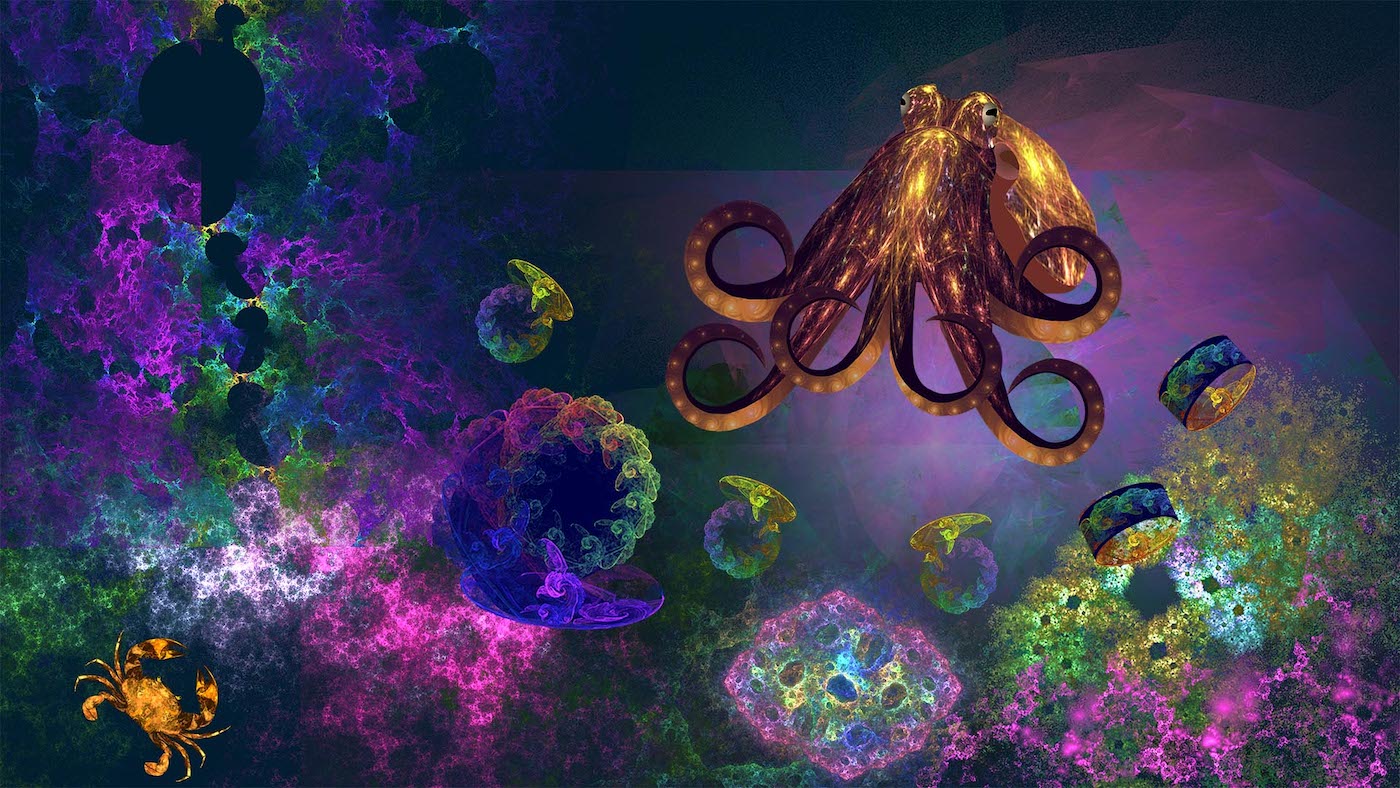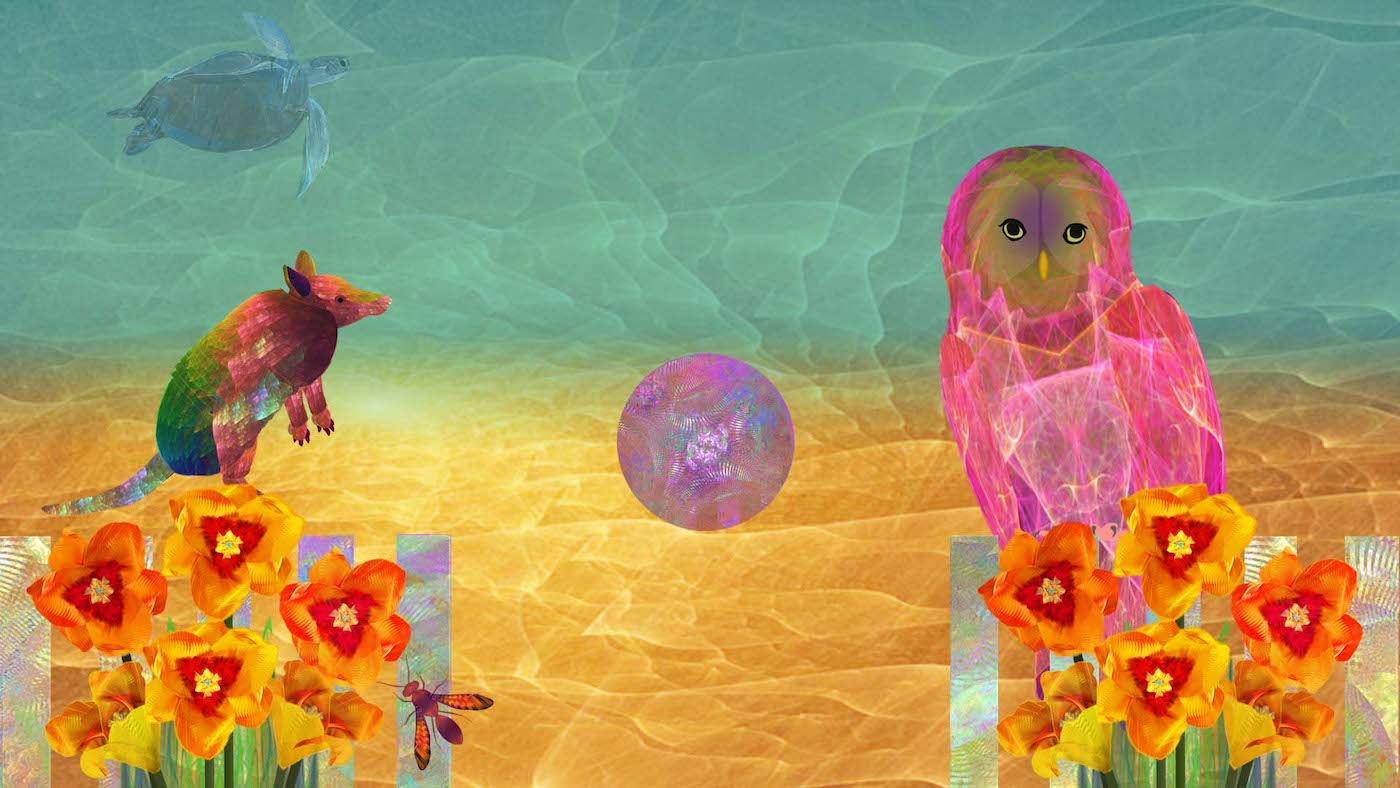Science-Inspired Art From Two ‘Universe of Art’ Listeners
6:30 minutes
Last week, we kicked off a first-anniversary celebration for Universe of Art, our science-meets-art spinoff podcast. A lot of listeners have written in since the start of the podcast, telling us about the science-inspired art they’ve made in their spare time.
Last week, host D. Peterschmidt spoke with Todd Gilens, a visual designer who worked with the city of Reno, Nevada, to create a mile-long poem on the city’s sidewalks about the connections between urbanism and stream ecology.
This time, we’ll meet two listeners. Craig Colorusso is a punk rock guitarist-turned-sound artist who creates public sculptures and experiences that enhance visitors’ connection to nature. Two of his projects, Sun Boxes and The Bridges At Coler, use solar panels to play reflective, calming music he composed. “You have this idea where you are in nature and you are listening to something that is powered by nature,” he said. “I think that’s perfect.”


And we’ll meet a listener who prefers to go by Chris, who was an engineer and avid artist who made mosaics and crocheted before developing Myalgic Encephalomyelitis, or Chronic Fatigue Syndrome (ME/CFS). It’s a debilitating condition characterized by extreme fatigue that can’t be improved by rest, and can also include brain fog, pain, and dizziness. It’s similar to what many Long COVID patients experience. Chris’ condition is considered severe, and caused her to lose the use of her hands, and thus her preferred art mediums.
However, Chris could still use her left hand with a rollerball mouse and realized that she could use programs like Chaotica to create fractals that she adds to collages in Photoshop, resulting in the colorful collages seen above. “They’re just beautiful and I’m doing art again and I’m so happy about it,” she said.
Invest in quality science journalism by making a donation to Science Friday.Donate To Science Friday
Craig Colorusso is a sculpture and sound artist based in Arkansas.
Chris is a collage artist who works with fractals.
IRA FLATOW: Last week, we kicked off a one-year birthday celebration for Universe of Art, our science-meets-art spinoff podcast. And a lot of you have written in since the start of the podcast telling us about the science-inspired art you’ve made in your spare time. The show’s host, D. Peterschmidt, has been talking to some of you to find out more. And today we’ll hear from two listeners who found unique ways to connect nature to their art.
CRAIG COLORUSSO: My name is Craig Colorusso, and I make things that make sound. More specifically, I make sculptures that have a sound element to them.
D. PETERSCHMIDT: We’ll get to what exactly those sounds are in a second. Spoiler alert, they’re very peaceful. But Craig, who’s based in Arkansas, wasn’t always interested in making contemplative sound art sculptures.
[PUNK MUSIC]
CRAIG COLORUSSO: Well, I started out in punk rock. I was in a bunch of bands, toured all over the country, and I love music. But at some point, I remember specifically being on tour and realizing there’s a barrier between the audience and the performer. And I think that’s fine, but I just didn’t want to be part of that. I wanted to make something where you could literally feel like you’re part of it.
D. PETERSCHMIDT: Craig remembers recording with a band he was in and coming to a realization in the studio.
CRAIG COLORUSSO: I wanted to do things more than just make sounds. And I realized that sculptures and paintings were informing the music I wanted to play more so than other music.
D. PETERSCHMIDT: He made that pivot a little over 20 years ago, and one project that ticked off everything on his new checklist was a piece called Sun Boxes.
CRAIG COLORUSSO: Sun Boxes is 20 speakers that are all individually powered by solar panels, and each box has its own guitar note that has been recorded and programmed to play continuously as long as there’s enough sun. The catch is that all those tracks are a different length, and so as they repeat, they line up differently.
[SERENE MUSIC]
D. PETERSCHMIDT: Can you describe the experience of just walking through them?
CRAIG COLORUSSO: Yeah I mean, as you’re in the middle of the array, you start to realize that, wow, there are 20 things making sound, and I can hear them all. It’s one of those things where it’s loud enough so the participant feels like they’re engulfed by sound. But at the same time, you can still hear ambient sounds of the environment, like wind and trees. You can hear animals like insects. You can hear people crunching on leaves as they walk. You know, it just makes me feel more– not necessarily presenting something but just enhancing what’s already here.
D. PETERSCHMIDT: Craig did a similar project for the Coler Mountain Bike Preserve in Northwest Arkansas, still using solar panels. But a power speaker is embedded in a pedestrian bridge, which play a similar kind of composition made up of guitar, clarinet, and bass clarinet.
CRAIG COLORUSSO: Yeah, I’m a big fan of solar. And now you have this idea where you are in nature, and you are listening to something that is powered by nature. I think that’s perfect. I didn’t want this to be an art experience– you know, art with a capital A. I just wanted this to possibly make someone’s day better.
D. PETERSCHMIDT: And actually, Craig’s heard from a handful of people whose day was made considerably better by this piece called The Bridges at Coler.
CRAIG COLORUSSO: One couple got married on the bridge, and another fella proposed to a woman on the bridge. And, you know, I thought it was just great that I made something that people want to include in these, like, milestones of their lives.
[SERENE MUSIC]
D. PETERSCHMIDT: And for our last listener artist, we’re going to hear from a woman who wants to go by Chris. And Chris has ME/CFS, which, if you haven’t heard of it, stands for myalgic encephalomyelitis or chronic fatigue syndrome. People with this disease often experience extreme fatigue that can’t be improved by rest but can also include brain fog, pain, and dizziness. And because of this, Chris didn’t have the energy for an interview. So instead, we communicated over email. And with her permission, I asked my co-worker Annie to read a condensed version of what she wrote to me.
ANNIE: I have ME/CFS. I’m considered severe housebound and bed bound during relapses. I can do my basic daily self-care activities, but my husband does all chores.
D. PETERSCHMIDT: Chris got 18 years ago after she contracted a virus. She was an engineer for a cell biology research company where she made software and complex gadgets.
ANNIE: And early on, I couldn’t do advanced math and logic anymore.
D. PETERSCHMIDT: She thought it was just the flu at first, and to feel better, she tried working out to reduce symptoms. It had the opposite effect.
ANNIE: I ended up exercising myself into full disability over 6 months. I finally gave up when I realized I was too weak to drive to work.
D. PETERSCHMIDT: In the ME/CFS world, this is known as post-exertional malaise. Long COVID patients can experience the same thing. And before this, Chris was a pretty active artist in her spare time, dabbling in drawing, painting, mosaics, and crocheting. But her hands stopped working well enough to do physical art.
ANNIE: I don’t really get to start with an idea and then make something anymore.
D. PETERSCHMIDT: And Chris was at a loss. Art can be such a steadying, calming force in your life, especially if you’re dealing with a chronic health condition. Was there a way that she could work within the limitations of ME/CFS and still create?
ANNIE: Then I discovered fractals.
D. PETERSCHMIDT: Chris found out that she could still use her left hand with a rollerball mouse to navigate Photoshop.
ANNIE: I create worlds and characters using fractals from programs like Chaotica and Apophysis. I generate them randomly and pick out the beautiful ones. The fractals can supply beautiful backgrounds that I assemble into worlds of trees, grasses, flowers, oceans, rivers, rocks, stars, and planets. Then in Photoshop, I map sections of the fractals onto shapes of an animal– wings, face, body. The fractals supply the detail and intense colors since so much of nature has a fractal character to it.
The result is whimsical, beautiful, humorous, and abstract, like nature. The randomness of the fractal generation gives the process a feeling of discovery. They’re just beautiful. And I’m doing art again, and I’m so happy about it.
Had I known about post-exertional malaise soon enough, I may not be housebound, and I might still be able to use my right arm and hand for art. Art does give me a cushion between me and the cruelty of ME/CFS. Even now, 18 years later, I miss my work and colleagues and that feeling of contributing to the world. But art is glittering around the edges, making me smile.
D. PETERSCHMIDT: Thanks, Chris. And you can check out Craig and Chris’s art on our website. That’s at sciencefriday.com/listenerart. I’m D. Peterschmidt.
Copyright © 2024 Science Friday Initiative. All rights reserved. Science Friday transcripts are produced on a tight deadline by 3Play Media. Fidelity to the original aired/published audio or video file might vary, and text might be updated or amended in the future. For the authoritative record of Science Friday’s programming, please visit the original aired/published recording. For terms of use and more information, visit our policies pages at http://www.sciencefriday.com/about/policies/
Dee Peterschmidt is a producer, host of the podcast Universe of Art, and composes music for Science Friday’s podcasts. Their D&D character is a clumsy bard named Chip Chap Chopman.